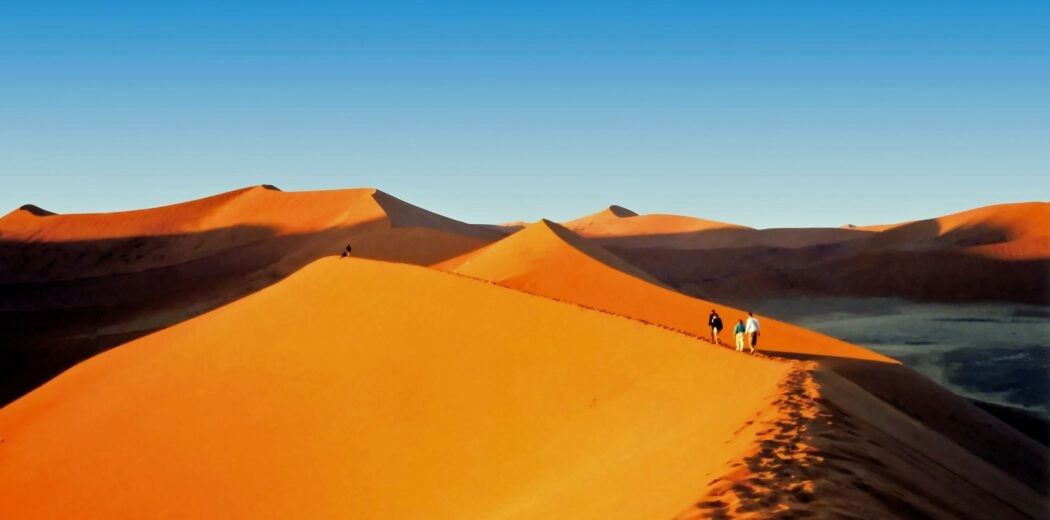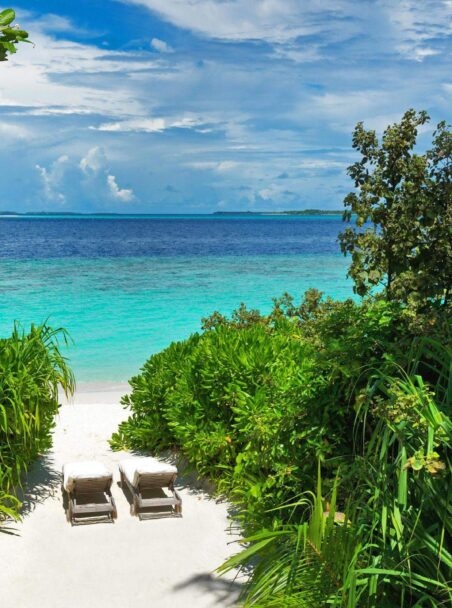Seeking out the most remote place in the world is an exciting proposition. Travelling to secluded areas and lesser visited locations can be a hugely rewarding experience, connecting you deeply to the environment you’re visiting. Our favourite remote vacation spots are prime for snowy adventures or sundrenched relaxation on private islands. You might come across a beautiful national park teaming with wildlife or a calm, tranquil romantic tropical paradise for a slow travel experience.
To help you find your own off-the-beaten-track dream adventure our team of expert travel designers have compiled a list of their favourite remote travel locations around the globe. They’ve included a plethora of useful information on how to get there, where to stay and what to do while you’re there.

French Polynesia, South Pacific
French Polynesia is made up of 121 islands and 5 archipelagos and is situated in the vast expanse of the South Pacific. It’s one of the world’s most remote and secluded travel destinations with Australia some 6,000 kilometres to the east and Chile more than 7,500 kilometres to the west.
On tiny Tetiaroa Island, reached only by light aircraft, you’ll find the remote, luxurious retreat of The Brando. This exclusive resort, miles from anywhere, carefully combines opulence with sustainability. Cool seawater is used to power the natural air conditioning system and 60% of hotel’s energy is generated by solar power. By supporting community initiatives, conservation projects, education and research The Brando has become a model for sustainable luxury in one of the world’s most remote locations.

Ladakh, India
Ladakh in northern India is one of the nation’s least densely populated and most remote regions. Its vast expanse, featuring the rugged snow-covered Himalayan, Zanskar, Ladakh, and Karakoram mountains, makes many areas inaccessible by road for over six months a year, preserving its seclusion.
Once a sovereign Buddhist realm, Ladakh has maintained its cultural traditions due to its isolation. The region offers beautiful hiking through pristine mountain ridges, small villages and verdant valleys. We recommend letting Shakti, featured on our list of the world’s best hiking experiences, lead you on multi-night routes to explore Ladakh’s natural beauty and cultural richness. It’s a brilliant destination choice for those interested in trek travel.

Mustang, Nepal
Mustang, Nepal, sits high in the Himalayas close to the immense Tibetan Plateau, one of the planet’s highest altitude areas. Neighbouring the famous Annapurna region and flanked by some of the world’s tallest mountains, including the 8,167 metre Dhaulagiri, Mustang is among Nepal’s most isolated places. Until 1992, it was closed to foreign visitors, preserving its strong Tibetan traditions and limiting social change and industrialization.
The region’s capital, Jomsom, a town with a population of just 1,370, now has a small airport, making it fairly easy to access from the capital Kathmandu, via the lakeside town of Pokhara. Luxury travel in remote Mustang can be found at the contemporary Shinta Mani Mustang hotel, which respects local culture and natural wonders. The hotel supports the Pasang Lhamu Foundation, aiding women from remote regions in Nepal.

The Kimberley, Australia
With 75% of Australia classified as ‘very remote’ [ABS.gov], the Kimberley, in Western Australia, stands out as a particularly isolated region, epitomising ‘the middle of nowhere’. This ancient land is characterised by waterfalls, towering cliffs and rocky outcrops featuring Precambrian rocks that are over two billion years old, and some of the oldest rock art in the world.
Exploring the Kimberley’s vast wilderness is challenging due to its few connecting roads and expansive distances. It can take days to travel from place to place. A luxurious way to experience the Kimberly is aboard the True North motor yacht. Onboard itineraries typically last between one and two weeks with cruises to waterfalls, secluded beaches and the opportunity to try stargazing, hiking, gorge swimming and much more.

Skeleton Coast, Namibia
Namibia is often described as otherworldly, with its enormous orange sand dunes, vast deserts and petrified forests. The Skeleton Coast is 500 kilometres of largely uninhabited coastline, named for whale skeletons and shipwrecks washed up by dangerous currents and wind. Its eerie namesake, dense sea fog and swirling sandstorms make this place particularly hostile and remote.
When the dust settles and fog dissipates a wildlife-rich region of desert-adapted elephants, lions and giraffes is revealed, there’s also ancient rock art to discover. To get a sense of this remote location, while cocooned in a luxurious bubble, stay at Wilderness Hoanib Camp which is only accessible only by scenic flights. Positive impact is prioritised here, with local communities benefiting from land-lease agreements, and wildlife protected by anti-poaching programs and conservation efforts.

Mahale Mountains, Tanzania
In western Tanzania you’ll find Lake Tanganyika, the country’s largest lake which borders the Democratic Republic of Congo, Burundi and Zambia. Along the Tanzanian shores is the lush Mahale Mountains National Park, home to critically endangered chimpanzees. The park’s impenetrable forest clings to towering mountains, making this one of Tanzania’s most remote travel destinations.
Greystoke Mahale is a lakeside camp built from natural materials, including recycled wooden boats that backs onto the forest. The camp provides daily guided walks to observe the chimpanzees with expert guides, and trackers who affectionately consider these primates as family. Reaching Greystoke Mahale involves a series of light aircraft flights and a boat ride, making it an exclusive, secluded paradise.

Southern Peruvian Amazon, Peru
The mighty Amazon rainforest spans the borders of eight South American countries, plus the French territory of French Guiana. Its lush, dense interior and changing water levels make it notoriously difficult to navigate. Travelling to such a fragile and important environment means considering the ethical and safeguarding implications too.
The Southern Peruvian Amazon, near the borders of Brazil and Bolivia, showcases how remote locations can become meaningful travel destinations. Posada Amazonas lodge, part of Jacada’s positive impact hotel collection, works with communities to ensure they benefit financially from tourism and design activities so that you can experience nature without negatively impacting the forest or the people who live there.

Corcovado and Osa Peninsula, Costa Rica
Corcovado National Park, one of Central America’s largest tropical rainforests, covers over half of Costa Rica’s Osa Peninsula. It’s known for its intense biodiversity and natural significance and, despite its size, it remains one of the country’s more remote areas. Pristine beaches, lush jungles and thriving wildlife make it one of the world’s great remote nature destinations.
Overlooking the Golfo Dulce, only accessible by boat and with dense jungle as backdrop, the luxurious, boutique Playa Cativo lodge is immersed in nature. Enjoy the private beach and swimming pool or wander the vegetable garden with the resident chef. Playa Cativo protects 100 acres of primary rainforest as well as using renewable energy. To protect the environment it employs eco-friendly practices such as using citronella repellents, eco-certified cleaning products and organic farming methods.

Siwa Oasis, Egypt
A list of remote travel destinations wouldn’t be complete without a desert oasis. Endless sand as far as the eye can see takes you totally off-grid. Our favourite example of exactly this is Siwa, an oasis high in western Egypt within the Sahara, the world’s largest desert. It takes over a day to drive here from the capital Cairo on roads that become desolate, with few settlements nearby.
For an authentic desert experience stay at Adrere Amellal, a handcrafted hotel furnished by local artisans with beds carved from salt. The sustainably focused property has no plastic or electricity so evenings are illuminated only by candles, creating a magical desert atmosphere. Of all the activities here we highly recommend a night of spectacular stargazing in one of the world’s remote corners.

Salalah and the Empty Quarter, Oman
In southern Oman, over 1000 kilometres from Muscat, lies the remote city of Salalah. Famous for frankincense, fresh seafood and the renowned lush, green Khareef monsoon season. Salalah is the gateway to the Empty Quarter, one of the Middle East’s most remote travel destinations. This vast desert spans the southern Arabian Peninsula, where sand dunes meet dramatic coastlines of cliffs, beaches and fjords.
Stay at Alila Hinu Bay on a pristine beach in the Empty Quarter where camels roam freely. Striving for organic self-sufficiency, the hotel harvests ingredients from its vegetable garden, and with dining options in quiet corners or under the stars, you’ll find a profound sense of solitude and immersion in nature.

Kornati National Park, Croatia
For a genuine taste of remote solitude in Europe, visit Croatia‘s Kornati National Park, an archipelago of 89 UNESCO-protected islands. With only 24 full-time residents and minimal tourism, Kornati stands out as one of the region’s most peaceful island destinations. Best accessed on a boat trip from Zadar, you’ll be able to navigate countless deserted coves, pristine islands, sparkling waters, abundant birdlife and dramatic kast-formed cliffs (some of which are over 65 million years old).
For a complete immersion in tranquillity, we recommend staying at Villa Nai 3.3 on Dugi Otok Island. The southern part of this island is included in the national park while the north and east are peppered with tiny villages and towns. While staying here you can enjoy coastal views, sea excursions, organic food and wellness activities. Relax in luxurious rooms beside an infinity pool, experiencing an authentic taste of Croatia without the crowds.

Svalbard, Norway
Svalbard, an archipelago around 800 kilometres from mainland Norway and 600 kilometres from the North Pole, is one of the world’s most remote travel destinations, with only 2,926 permanent residents as of 2021. This icy destination is accessible primarily via a flight from Oslo, Norway’s capital, and takes just under three hours, landing in Longyearbyen, Svalbard’s largest town.
On arrival we recommend venturing even further into nowhere for a stay at Isfjord Radio Adventure Hotel. This remote outpost has a rugged and desolate exterior that cocoons a cosy, comfortable chic hotel inside, the perfect base for exploring the surrounding landscapes. Isfjord is completely inaccessible by road and in winter you’ll arrive by dog sled or snowmobile, traversing glaciers and mountains, and in summer you’ll travel by boat safari across the Arctic Ocean.

The Faroe Islands
Halfway between Scotland and Iceland, the Faroe Islands are a remote volcanic archipelago in the Atlantic Ocean. Under Danish sovereignty yet self-governed, these 18 islands have a strong culture and distinct identity. The only convenient way to access the islands is on a flight to the only airport on the main island of Vágar. It’s then fairly easy to navigate around the different islands using a series of bridges, tunnels and boat crossings.
The scenery is breathtaking with lush green valleys, sheer cliffs, and vast moors ideal for hiking, cycling and climbing. In the picturesque towns and villages you’ll discover a rich Faroese culinary heritage using local produce and technique, that reflects their isolated way of life. Be sure to sample the staples of fermented meat and fish, root vegetables, herbs and wild plants.
Feeling inspired? Our expert travel designers are always on hand to help you pick the most untouched locations for your remote escape.















